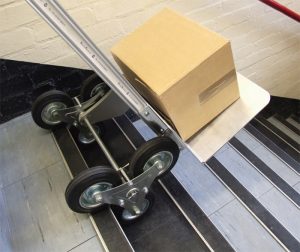Manual handling is not just used in the heavy-duty workplace such as warehouses, ports or factories. We use manual handling technique in everyday activities everywhere. Cooking in the kitchen, typing in the office, caring for patients in the hospital, cleaning the garden and all other activities require good body posture to prevent us from injury.
 One activity full of manual handling tasks we’ll talk about in this article is moving house. You’ll need to move small and large furniture from one room to another, to the van, to the truck, or maybe to the storage unit. You might need to climb up or go down the stairs with your hands full of bulky items. And don’t underestimate the packing boxes and suitcases either. Lift them the wrong way, not-so-heavy items can also give you the risk of injury. But don’t worry, you can reduce the risk when performing manual handling tasks by following these tips.
One activity full of manual handling tasks we’ll talk about in this article is moving house. You’ll need to move small and large furniture from one room to another, to the van, to the truck, or maybe to the storage unit. You might need to climb up or go down the stairs with your hands full of bulky items. And don’t underestimate the packing boxes and suitcases either. Lift them the wrong way, not-so-heavy items can also give you the risk of injury. But don’t worry, you can reduce the risk when performing manual handling tasks by following these tips.
- Being physically fit.
- Maintaining correct posture as spinal alignment will ensure that the load is evenly distributed. The spine should be kept in its normal curves.
 Wearing comfortable clothing and enclosed toe shoes.
Wearing comfortable clothing and enclosed toe shoes.- Warming up prior to task.
- Cooling down after task.
- Removing any obstacles. Don’t let yourself exposed to the slipping or tripping hazards.
- Avoid twisting and bending.
- Avoid over reaching. Move your body close to the load, secure your grip and hold the load close to your body.
- Keeping hands at waist when lifting for better control, while holding your head upright.
- Powering the lift with legs and body weight, not with your hands or shoulders.
- If doing a one-handed lift, rest other hand on your knee to assist with spinal alignment.
- If you need to operate some manual equipment such as trolley or heavy-duty trolley, make sure you know how to operate it and read the manual/instruction if available.
- Positioning feet in a scissor formation, shoulder-width apart, when lifting above shoulder or below knee.
- Planning the movement of items before starting the move, this includes:
– assessing the load size, shape, level of stability and weight,
– clearing a path,
– checking the route for ramps, and
– agreeing how many people are required and roles and/or timing.
These illustrations below may give you a good general understanding of the correct and incorrect positions for manual lifting.
Risk of injury can increase if the load is very heavy or if you are sick or tired. You may want to consider using a professional removal service or asking some friends, neighbours or family members to help you for the special load. The most important thing, if you don’t feel confident to lift and move an item by yourself (because it’s too heavy/awkward or you don’t feel well or the path is hazardous), do not force it! It’s wise to seek and wait for assistance and get your moving going safely.
For more tips about safety during your house moving activities, read an article from our sister company Koala Box here http://www.koalabox.com.au/safety-tips-for-when-you-move/





